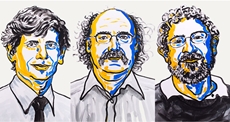Three British scientists share Physics Nobel
04 Oct 2016
This year's Nobel Prize in physics has been awarded to David Thouless, Duncan Haldane and Michael Kosterlitz – the three scientists who 'revealed the secrets of exotic matter'.
 | |
| David J. Thouless (left), F. Duncan M. Haldane, and J. Michael Kosterlitz (right) / Illustration: Ill: N. Elmehed. © Nobel Media 2016 |
''David Thouless, Duncan Haldane and Michael Kosterlitz were together given the prize for their work in physics. Each of them worked to use topological concepts in physics – a branch of mathematics that has been put to use in finding new information about the world,'' the Nobel Prize Committee stated in a release.
Their discoveries helped illuminate how in some realms matter can exist in strange states, and in doing so helped scientists work with new forms of materials.
David Thouless wins one half of the award himself. The other half will be split between Duncan Haldane and Michael Kosterlitz.
All three of the winners were born in the UK but now work in the US. Thouless, 82, is a professor emeritus at the University of Washington. Haldane, 65, is a physics professor at Princeton University in New Jersey. Kosterlitz, 73, is a physics professor at Brown University in Providence, Rhode Island.
''Their work is far older than that on gravitational waves – with the winning research being conducted in the 1970s and 1980s. The Nobel Committee often wait before they give out awards, making sure that the research is not contradicted.
''The judges cited the huge impact of the scientists' discoveries in explaining why they had been given the award. Much of that has only become clear in recent years – as the discoveries have made their way into electronics and materials physics – despite the discoveries themselves being made so long ago.
"This year's Laureates opened the door on an unknown world where matter can assume strange states," the judges said. "They have used advanced mathematical methods to study unusual phases, or states, of matter, such as superconductors, superfluids or thin magnetic films.
"Thanks to their pioneering work, the hunt is now on for new and exotic phases of matter. Many people are hopeful of future applications in both materials science and electronics."
In the early 1970s, Michael Kosterlitz and David Thouless overturned the then current theory that superconductivity or suprafluidity could not occur in thin layers. They demonstrated that superconductivity could occur at low temperatures and also explained the mechanism, phase transition, that makes superconductivity disappear at higher temperatures.
In the 1980s, Thouless was able to explain a previous experiment with very thin electrically conducting layers in which conductance was precisely measured as integer steps. He showed that these integers were topological in their nature. At around the same time, Duncan Haldane discovered how topological concepts can be used to understand the properties of chains of small magnets found in some materials.
We now know of many topological phases, not only in thin layers and threads, but also in ordinary three-dimensional materials. Over the last decade, this area has boosted frontline research in condensed matter physics, not least because of the hope that topological materials could be used in new generations of electronics and superconductors, or in future quantum computers.
Current research is revealing the secrets of matter in the exotic worlds discovered by this year's Nobel Laureates.
The physics prize is the second to be announced this week. They began on Monday, with the announcement that Japanese cell biologist Yoshinori Ohsumi won for his work on autophagy, the process whereby cells break down and recycle themselves (See: Japanese biologist Yoshinori Ohsumi wins 2016 Nobel for Medicine).






























